
Goodfellas is maybe the ultimate “drop everything and watch” movie. So many times I’ve come across it on cable, intending to catch only a few minutes between commercials for something else, only to wind up fully engrossed hours later, in a movie I’ve already seen more times than I can count.
Goodfellas wasn’t sold or structured as a comedy, per se, but it seems to be every comedian’s favorite movie, and for good reason. Each watch seems to deepen my appreciation, and Lebowski-like, it gets funnier every time. At this point it’s almost more like a classic album than a movie, a series of irresistible melodies and favorite bits that change a little with each subsequent viewing. Even within individual scenes I find new characters and reactions to enjoy.
Goodfellas turns 30 this month, and it continues to age like a fine wine. For its anniversary, in lieu of another thinkpiece or oral history, I thought we’d treat it more like an album, and rank it scene by scene.
15. Helicopters Following Henry / Lois And Her Goddamned Hat

I put this scene at the bottom not because it’s the worst — in fact it’s one of the greatest portrayals of cocaine paranoia in all of cinema — but because of my sheer hatred for Lois and her goddamned hat. Lois, if you’ll remember, is the Hills’ babysitter, who Henry has roped into the drug trade. She borrows babies to pose as a young mother on flights to ferry cocaine to Henry’s partners.
The final scene before Henry gets pinched sees him trying to simultaneously pick up his brother from the hospital, cook up a nice ziti with meat gravy for his brother’s dinner that night, offload some stolen guns, cut the package of cocaine at the house of Sandy (Henry mistress 2A-1, played by Debi Mazar), before taping all the drugs to Lois and getting her on a smuggling flight, all while Henry is pretty sure he has helicopters tracing his every move.
The whole thing is a perfect depiction of the kind of over-ambitious multitasking one might attempt in the midst of a cocaine binge. It’s so effectively communicated that it remains weirdly relatable even if you don’t do cocaine, have mistresses, or break the law. Sometimes we just try to do too much, you know? Henry’s day of helicopters, cocaine, guns, mistresses, mules, and Sunday Gravy is just the logical extension of that. (Fun fact: the doctor who tries to get Henry to take it easy is Isiah Whitlock Jr., who would go on to play Senator Clay Davis on The Wire. Sheeeeeeeeit.).
And then there’s Lois (played by Welker White, who returned as Mrs. Hoffa in The Irishman).
In a movie of nuanced, fully fleshed out characters, Scorsese and Pileggi’s decision to make Lois the Babysitter, of all people, an absolute unmitigated pill, is a perfect contrast. On this night, she flat out refuses to go anywhere unless Henry drives her to Far Rockaway to get her lucky hat. “It’s my lucky hat. I don’t fly without it.”
Is it even possible to hate a person more than I hate Lois in that moment? I hate her so much that every time I watch Goodfellas, I forget that Henry didn’t actually get busted because of the hat. He never even got out of the driveway. That’s how powerful Goodfellas is: even after two hours of watching Henry Hill make terrible decisions, Scorsese so effectively puts me in the mind of his protagonist that for a second I can pin all his misfortune on one bratty babysitter. Screw your hat, Lois, you’re ruining everything.
14. Karen Realizes She’s Going To Get Whacked
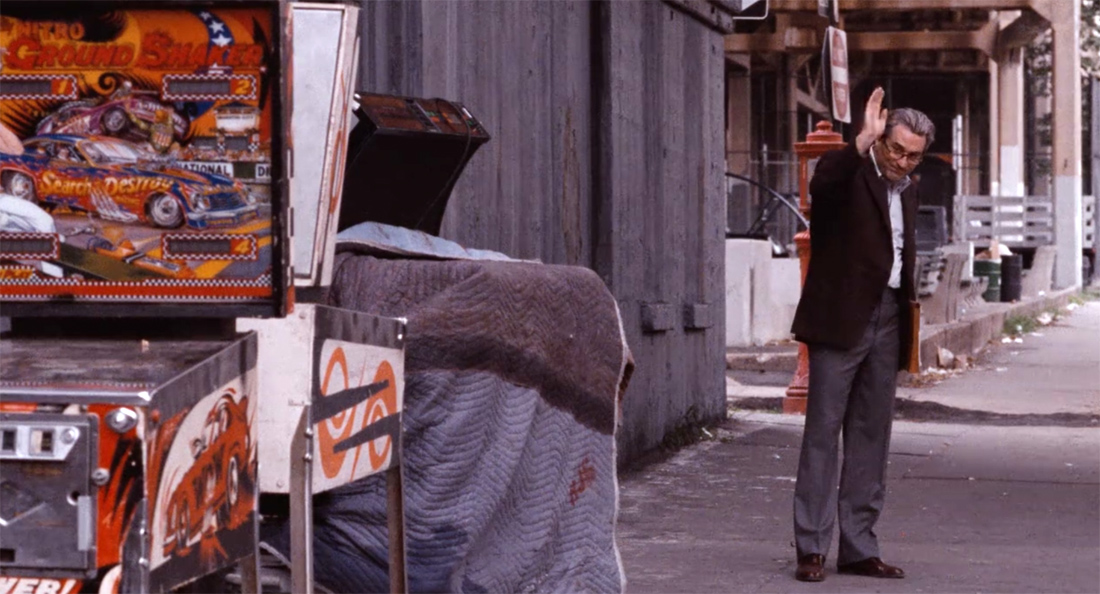
The beauty of Goodfellas is that whereas the Godfather gave us the mafia from the perspective of its royalty (“real greezeball shit,” as Henry Hill might say), Goodfellas is about your average wiseguys. Its protagonists are guys whose greatest ambition in life is that maybe one day someone in their crew might become a made guy. In that context, the way Henry begins fearing he might get whacked is suitably anti-cinematic (“If you’re part of a crew, nobody ever tells you that they’re going to kill you. Doesn’t happen that way. There weren’t any arguments or curses like in the movies. See, your murderers come with smiles, they come as your friends…“).
Of course, ambiguity is much scarier than open antagonism. An authoritarian state doesn’t keep you in line with tons of draconian rules, it keeps you in line with an absence of them, ambiguity mixed with the knowledge that crossing even an unspoken line can come with the ultimate consequence. We imagine that it’s the rigidness that’s scary, but really it’s the arbitrariness and caprice.
So it is that in one of Goodfellas‘ final scenes, Henry is convinced that he and Karen are marked for death, while Karen, thinking maybe he’s just being paranoid and maybe in a little bit of denial wanting to believe that they can keep their comfortable lives, goes to meet Jimmy. The scene that follows, in true Goodfellas fashion, is both deeply unsettling and subtly hilarious. Deniro’s Jimmy Conway coldly plans to have one of his oldest friends murdered, and does so in the most low-rent, Wile E. Coyote-ass way possible, trying to lure her into an alley with the promise of Dior dresses.
“Hey, Karen, my friend has some brand new Dior dresses for you. They’re over there. No, over there. A little further. There, keep going. Keep going, they’re right past the plastic sheeting, in that abandoned storefront, right next to the big spraypainted ‘X’…”
13. The Wave Of Whackings Set To Eric Clapton
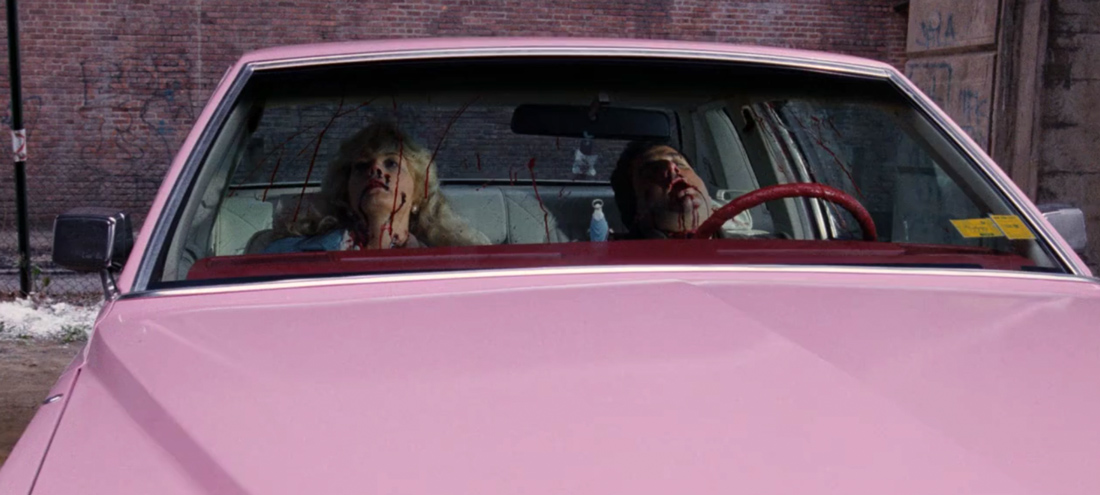
Scorsese is a master at removing the sheen of glamour from the mafia. Why does Jimmy have to kill basically the entire gang from the Lufthansa heist (the most successful score in history)? Partly because some of the gang is kind of annoying (especially Morrie, a classic noodge), but mostly because Jimmy is just such a tightass that he can’t bear to share the loot. So much mayhem from such mundane motives. And again, rather than a series of cinematic murders, Scorsese explains this with a montage of stinking corpses at the moment of their unglamorous discovery.
12. The Copa, Part 2: Sammy Davis Jr.
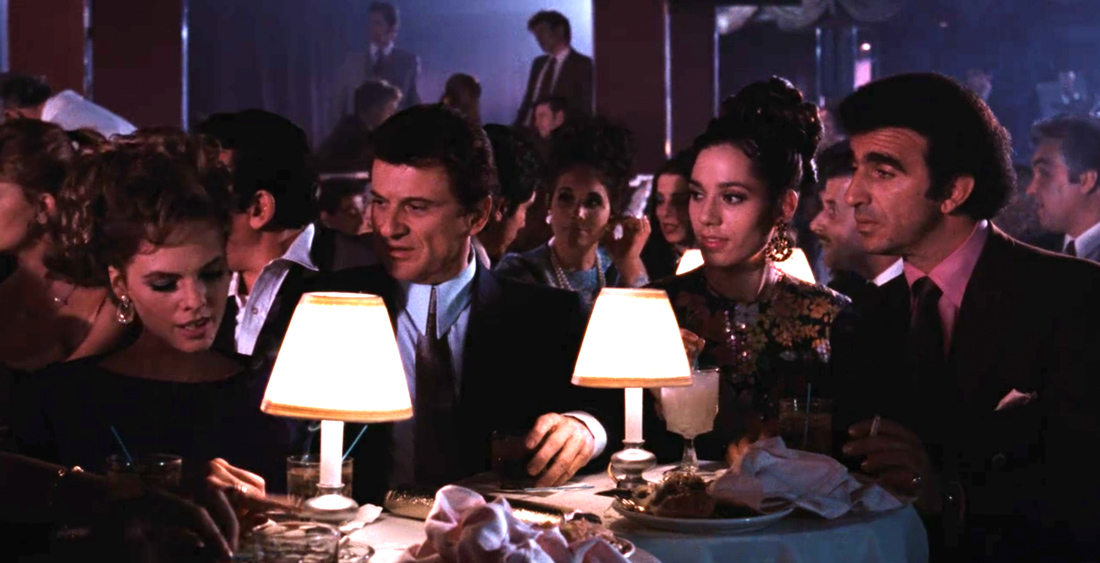
This scene is the button to an earlier scene, where Joe Pesci’s Tommy Devito is telling Henry that he can’t believe “a Jew broad” is “racist against Italians.” “You believe that? In this day and age?”
Then, later at the Copa, Tommy is so insecure that he can’t let it go when his date says she can understand how a white girl might fall for Sammy Davis Jr. “Oh, so you condone that stuff? I just wanna make sure I don’t wind up kissin’ Nat King Cole over here.”
The best filmmakers can construct brilliant scenes using only dumb and dull characters, and this is an absolute masterpiece of the genre (“He does these impressions? I’d swear you’d think it was the real people!”). Meanwhile, the whole thing takes place alongside human sight gag Frank Carbone (Frank Sivero). The “Nat King Cole” line doesn’t seem to be in any of the scripts, leading me to believe Pesci improvised it or someone suggested it on set. Pesci won an Oscar for Goodfellas, but he should probably have gotten ten of them for the sheer volume of enjoyment I’ve gotten out of this performance.
Fun Fact: In 2014, Frank Sivero sued The Simpsons for $250 million, arguing that they’d stolen his likeness for their character of Louie the mobster.
In his latest lawsuit, Sivero alleges that in 1989, he was living in an apartment complex in Sherman Oaks, California. He says that writers of The Simpsons were literally living next door to him in that same complex.
“They knew he was developing the character he was to play in the movie Goodfellas,” states the lawsuit. “In fact, they were aware the entire character of ‘Frankie Carbone’ was created and developed by Sivero, who based this character on his own personality.”
What, you make a mobster character and you don’t even let your neighbor get a taste? I’m just tryin’ to wet my beak a little here. (Also, Frank Sivero’s Instagram account is truly one of a kind.)
11. “What Kind Of People Act Like This?”
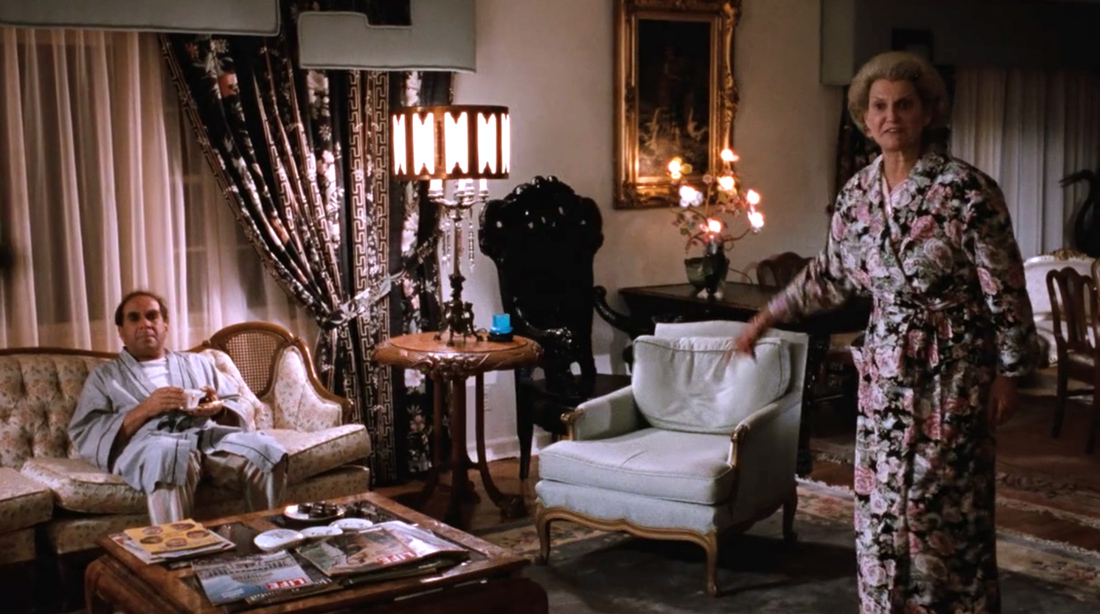
Italian-Americans and American Jews always seem to make such ideal literary foils, both mirroring each other’s stereotypes and acting as complementary opposites. In the sequence following Henry and Karen’s marriage, it’s hard to say what’s funnier, Karen trying to come to terms with Henry’s family or Henry trying to live with Karen’s. It’s a sequence that begins with Karen trying to keep track of all the Peters, Pauls, and Maries at their wedding, continuing through Karen’s horror at their nail salon gossip (the Italian women mistaking jealous rages for love is a consistent sub-motif in Goodfellas), culminating in Henry getting an earful from Karen’s overbearing mother (Suzanne Shepherd, who went on to play Carmella’s overbearing mother in The Sopranos).
“The man hasn’t been able to digest a decent meal in six weeks!”
10. Roughing Up The Mailman
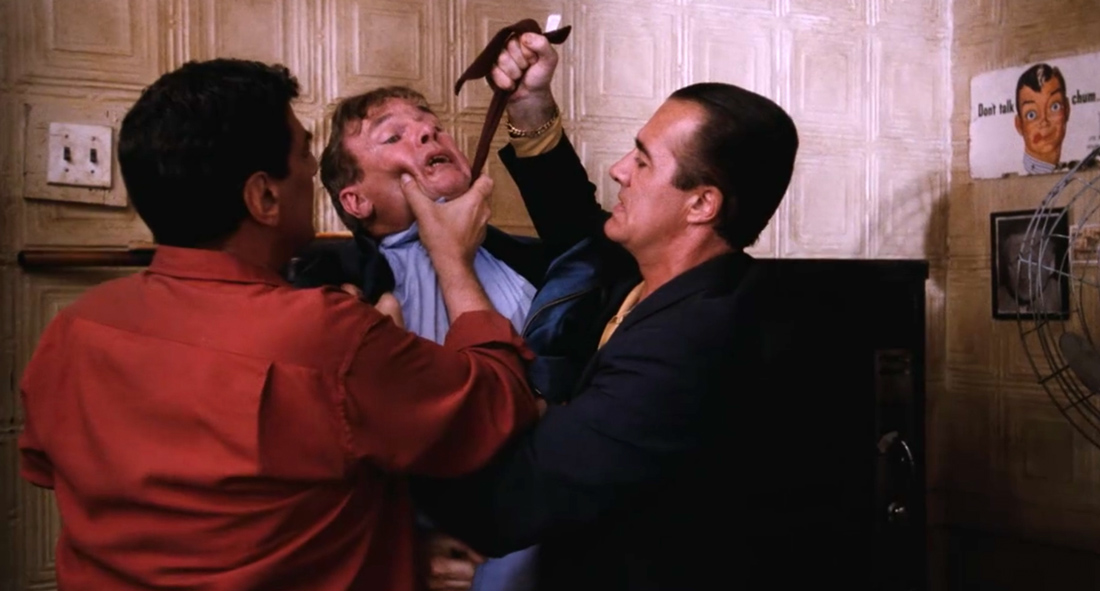
Young Henry’s parents are so angry about his report card that he might not be able to make deliveries for the gang anymore. Solution? Shove the mailman into a pizza oven and threaten his life if he ever brings another report card to Henry’s house. Bada bing, bada boom, problem solved. (Again, one of the things that makes Goodfellas great is that the characters aren’t that smart).
My second favorite sight gag in Goodfellas behind Frank Carbone’s eyebrows is Tuddy and his short little arms. (Fun Fact: Frank DiLeo, who played Tuddy Cicero, was a famous music executive who at one point was Michael Jackson’s manager).
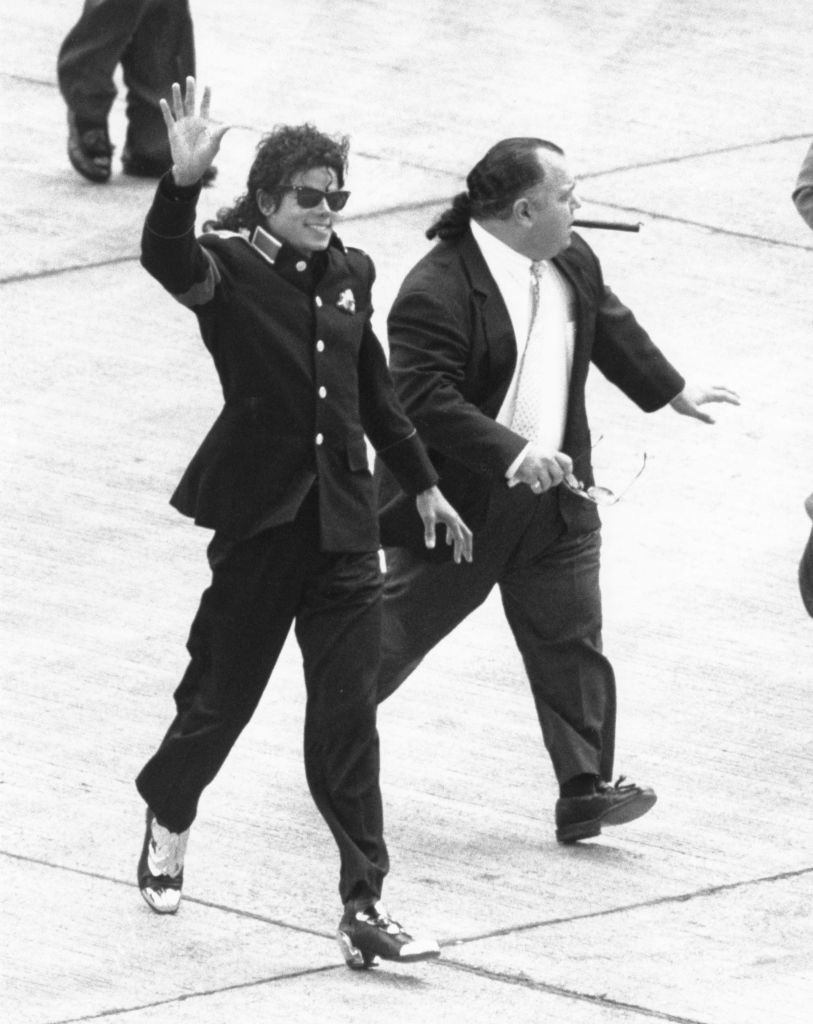
9. GET YOUR OWN GODDAMN MAN
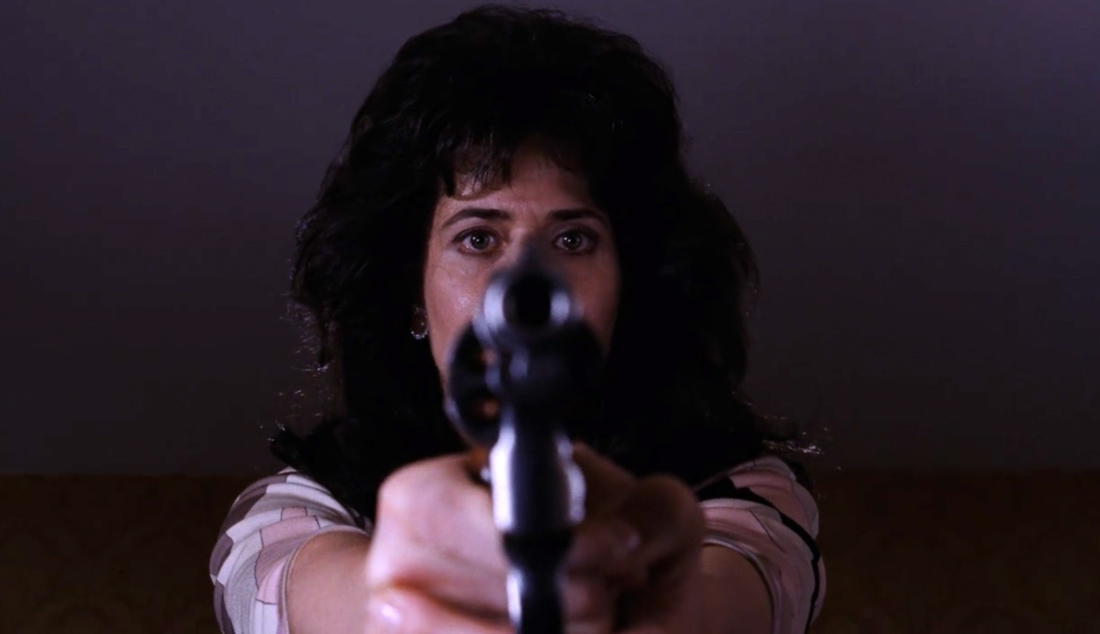
Lorraine Bracco’s depiction of Karen Hill is such an operatic performance, not just in terms of rage and broad emotion, but for sheer vocal output. Johnny Rotten famously said that his stage persona with the Sex Pistols had been inspired by Sir Laurence Olivier as Richard III, and I don’t know if Lorraine Bracco’s performance in Goodfellas has ever inspired a punk band but her booming chest voice cuts through you as good as any Minor Threat song. She channels that shriek from the ground up through her diaphragm and vomits it into the stratosphere. Death metal singers can only dream of channeling Lorraine Bracco letting loose into an apartment intercom.
YOU HAVE A HOO-AH! LIVING IN YOAH BUILDING! JANICE! ROSSI! TWO R! HE’S MYYYY HUSBAND! GET YOUR OWWWWN GODDAMN MAN!
An absolute banshee from hell with a voice like a buzzsaw. Lorraine Bracco in Goodfellas sounds like she has a Les Paul with a Marshall stack plugged into her larynx. I stand in awe of it.
8. Morrie’s Wigs
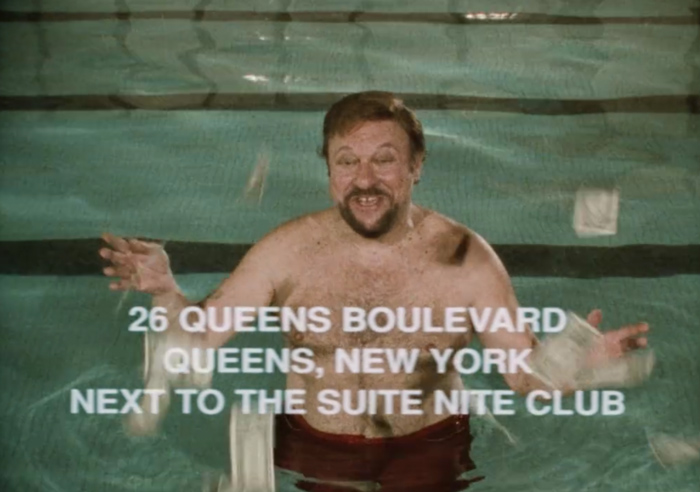
There’s so much backstory to Morrie’s wigs ad that I can barely do it justice in the space I have here. But suffice it to say, Morrie Kessler was based on Marty Krugman, a bookie who also sold wigs. The commercial itself was inspired by an ad for a window company called Aalco that played on Queen’s public access TV station.
One night, according to Joe Reidy, the first assistant director on Goodfellas, Scorsese saw a crude TV commercial for a windows company called Aalco, and wanted it to look exactly like that. He had his people track down the company’s boss, a man named Stephen Pacca who, they discovered, was also the guy on screen, selling his own product. They called him in for a meeting in view of having him consult on the Morrie ad, then asked him to make it himself, just as he did his windows ad. Scorsese left him to it.
The actor who played Morrie, meanwhile, Chuck Low, who is perhaps the single most eccentric and memorable minor character in the entire movie, was at one point Robert Deniro’s real estate consultant and landlord. It just goes to show: if you want your movie to have memorable characters, cast memorable characters.
7. The Pistol Whipping / “What Do You Want, F*cko?”
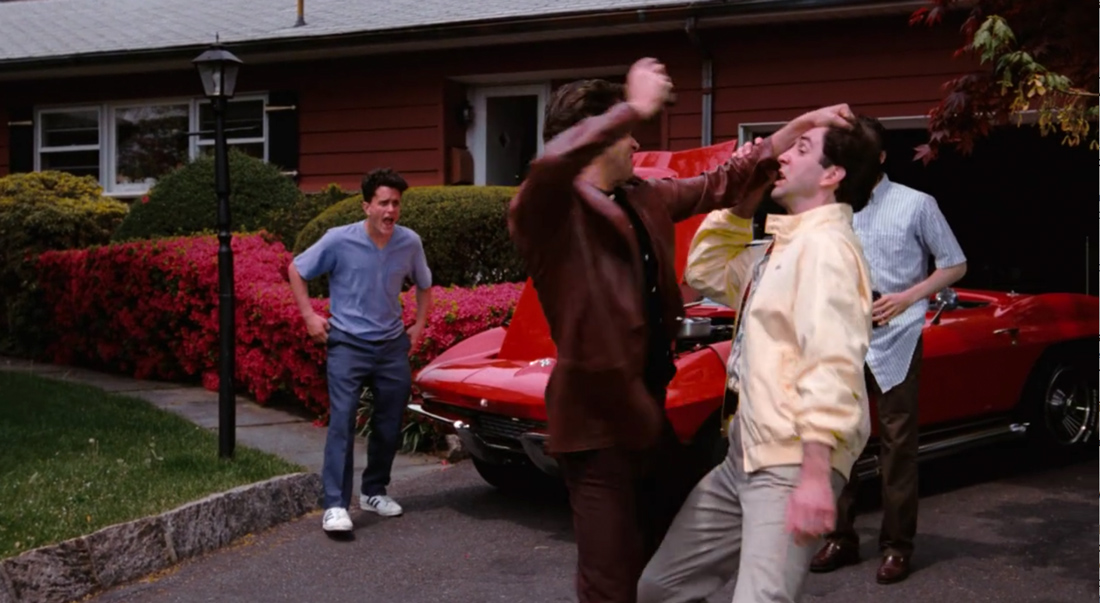
In a lesser movie, Karen would be a sidepiece, a footnote to the Henry character, but Goodfellas explores her psyche in nearly as much detail and nuance as it does Henry’s. Meanwhile, the scene where Henry comes after Karen’s rapey spoiled dork of a neighbor is a perfect illustration of the way Goodfellas manages to be simultaneously horrifying and hilarious.
In a weird way, I find this to be one of the funniest scenes in the movie. It’s a perfect bit from beginning to end, from the neighbor’s attempt at a blasé kiss-off (“What do you want, f*cko?” — you could make a drinking game out of people saying “f*cko” in Goodfellas) to the sheer number of times Henry pistol whips him to Karen’s weird arousal at the end. It gets a little funnier every time Henry hits the guy in the face with the pistol where the excessiveness itself is the joke, sort of like the boardroom scene in Robocop. The repetition also allows us to savor the horrified looks on the guy’s friends’ faces in the background.
This scene is essentially the place where two groups of similar frat bro-type dudes from different social classes collide, where leather blazer meets yellow Members Only jacket, if you will. Though it always bothered me that Henry doesn’t take his jacket off before beating the guy. You don’t want your arms constrained like that during a beat down, come on!
6. The Prison Feast
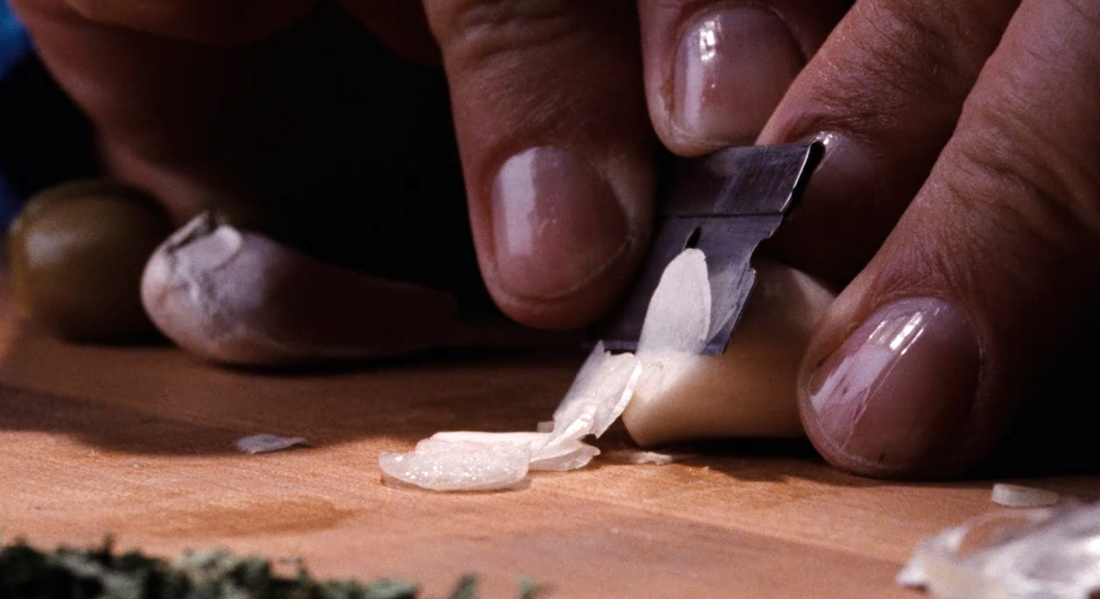
As an experienced home cook I would strenuously suggest that slicing your garlic paper thin so that it liquifies in a little oil is unnecessarily labor-intensive prep work with very little upside. Just smash the garlic and cook it gently at low heat. Or, use a little more olive oil, leave the garlic whole, sautee it on low for 10-15 minutes and then smash it with the back of a spoon once it’s soft. I digress, but the point is, anyone who has seen this movie remembers this scene and anyone who loves it has probably attempted some version of this meal themselves.
The beauty of this scene mostly speaks for itself. But in 30 years of rewatching this over and over, I think my current favorite part of it is Frank Pellegrino’s (as Johnny Dio) line read of “Oh, medium rare, an aristocrat.”
Such a Bugs Bunny-ass line read. It gets me every time.
5. The Copa, Part One / “You Don’t Seem Like You’re In Construction”
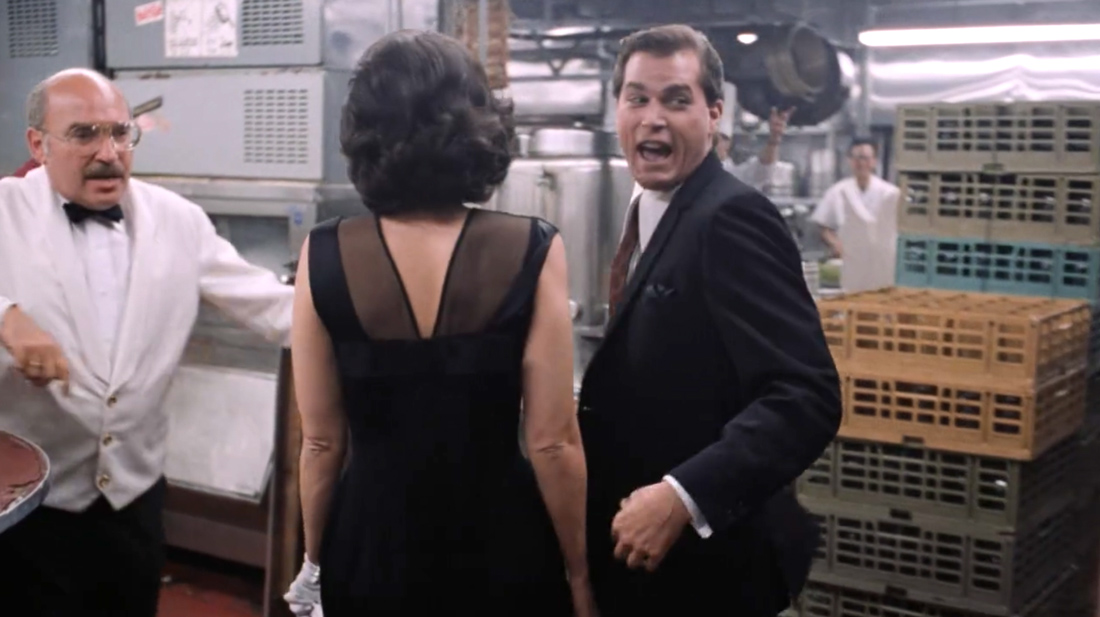
I’m fairly certain I don’t need to write another love letter to one of the most famous tracking shots in movie history. Suffice it to say, it’s very good. There’s so much nostalgia for a more face-to-face way of life wrapped up in just this one shot.
4. “F*ck You, Pay Me.”
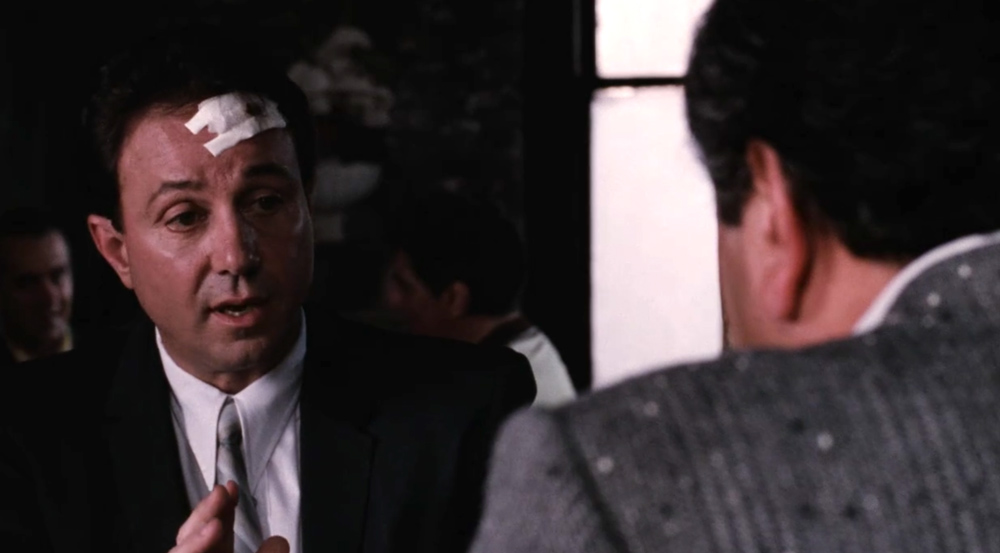
Sonny Bunz (played by Tony Darrow), the bumbling owner of the Bamboo Lounge, is probably my second favorite odd side character in Goodfellas behind Morrie. His feud with Tommy allows Paulie a piece of his restaurant (a terrible mistake and an entirely unforced error), leading to Goodfellas’ classic depiction of a break-out scheme — in which the mob comes in, runs up debts on the restaurant’s credit until it runs out and then burns the place down (which, incidentally, is more or less how private equity works).
This all culminates in one of the great monologues of the film, as Henry and Tommy sit outside the smoking restaurant, as Tommy tries to convince Henry to go on a double date with him. “Henry, do you believe this? A Jew broad, in this day and age, prejudiced against Italians.”
3. The Bamboo Lounge Introduction Montage / Funny Like A Clown
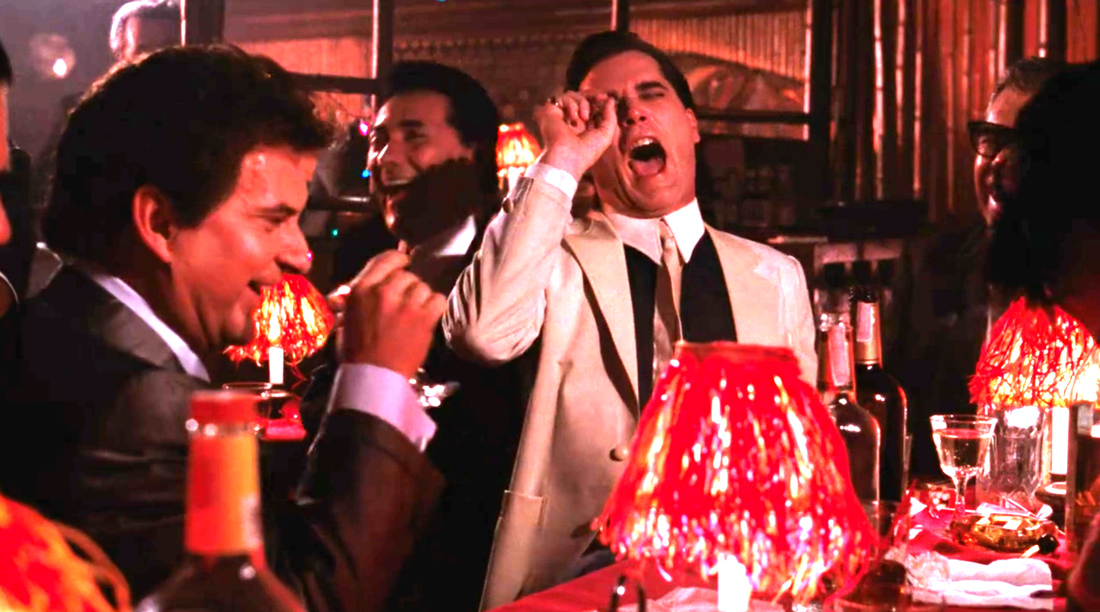
The “funny like a clown” scene tends to suck up a lot of oxygen in any discussion of Goodfellas, and for good reason. Pesci, not strictly “improvising,” though it wasn’t in the script, mostly came up with the bit based on something that actually happened to him. The range of emotion he goes through — not to mention his slapstick mannerisms throughout, from waving the gun around to diving at Henry afterward like a psychotic little doggy — is one of the most physically adroit displays of acting ever committed to film. It’s like Meryl Streep meets Buster Keaton. Again, Pesci deserves ten Oscars for this performance.
That said, the entire introduction montage that precedes it is arguably just as funny. That’s another, shorter tracking shot that introduces us to:
Jimmy, Tommy, and Me
Anthony Stabile
Franky Carbone
Moe Black’s Brother, Fat Andy
His guys, Franky The Wop
Freddy No Nose
Pete The Killer (Sally Balls’ brother)
Nicky Eyes
Mikey Francese
Jimmy Two Times (he’s gonna go get the papers, get the papers)
Magnificent. Incidentally, “Big Pussy” from The Sopranos (Vincent Pastore) gets a brief, unnamed cameo as the guy holding the coatrack.
2. I Thought You Said I’m Alright Spider
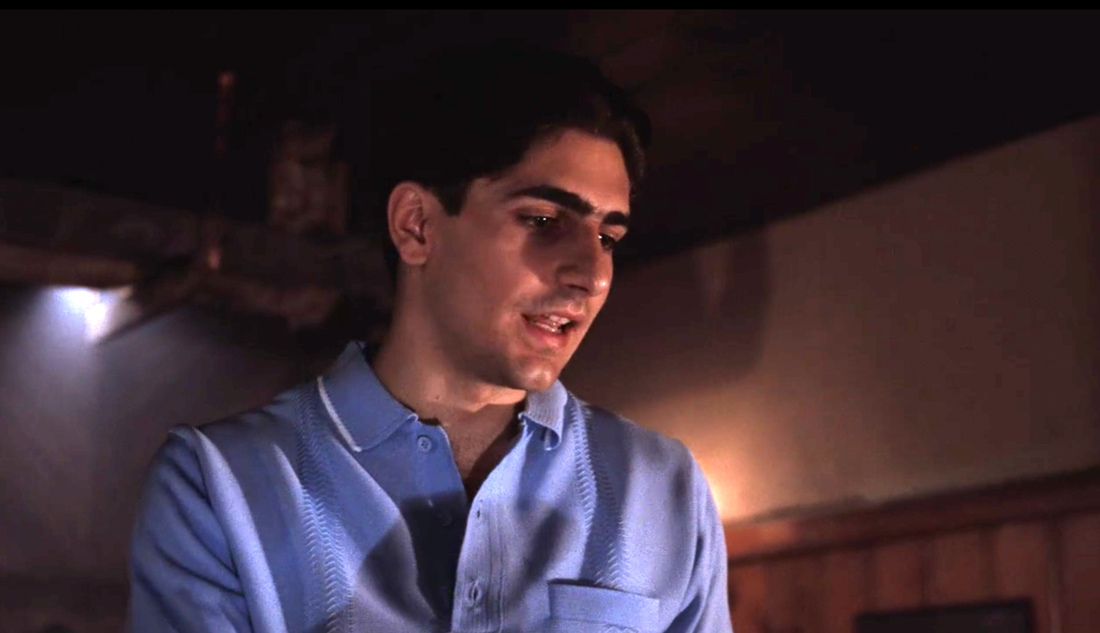
Scorsese just couldn’t let it go without reminding us that for every Henry Hill, a kid who finds a fortune, friendship, and a second family in the mafia, there’s a Spider, a guy who gets his corpse thrown in a landfill for objecting too loudly to being shot in the foot. And once again, Joe Pesci plays the whole scene with a brilliant mix of insecurity and overcompensation.
When his joke about being “The Oklahoma Kid” falls flat (on account of shooting Spider in the foot) Tommy accuses Spider of milking his injury and being melodramatic. When Spider comes back and Tommy tries to bust his balls about his cast like it’s all a big joke (which, if Spider had gone along with it, would presumably have absolved Tommy of his shooting faux pas), Tommy bombs again. When Jimmy busts Tommy’s balls about it in turn (“come on, you gonna take that? what’s the world coming to!”), Tommy can’t handle the embarrassment and shoots Spider in the chest.
Aside from the general insecurity, there’s a failed comedian rage in Tommy, perhaps foreshadowing the entire Joker movie (which, if nothing else, was heavily influenced by Scorsese). Then the way Tommy tries to play it all off like it’s no big deal (“So what, I’ll dig the hole. You think I’ve never dug a hole before? I dug a million holes…”) is almost I Think You Should Leave-esque in its comedy of guy-refusing-to-admit-when-he’s-wrong. Like so many Goodfellas scenes, it works perfectly as a stand-alone sketch.
It was a brief role for Michael Imperioli, who would go onto become one of the best actors in The Sopranos, but even in a film full of Oscar-winning heavy hitters, “I thought you said I’m alright, Spider” stands out as one of the most memorable lines.
1. One Dog Goes This Way, The Other Dog Goes That Way
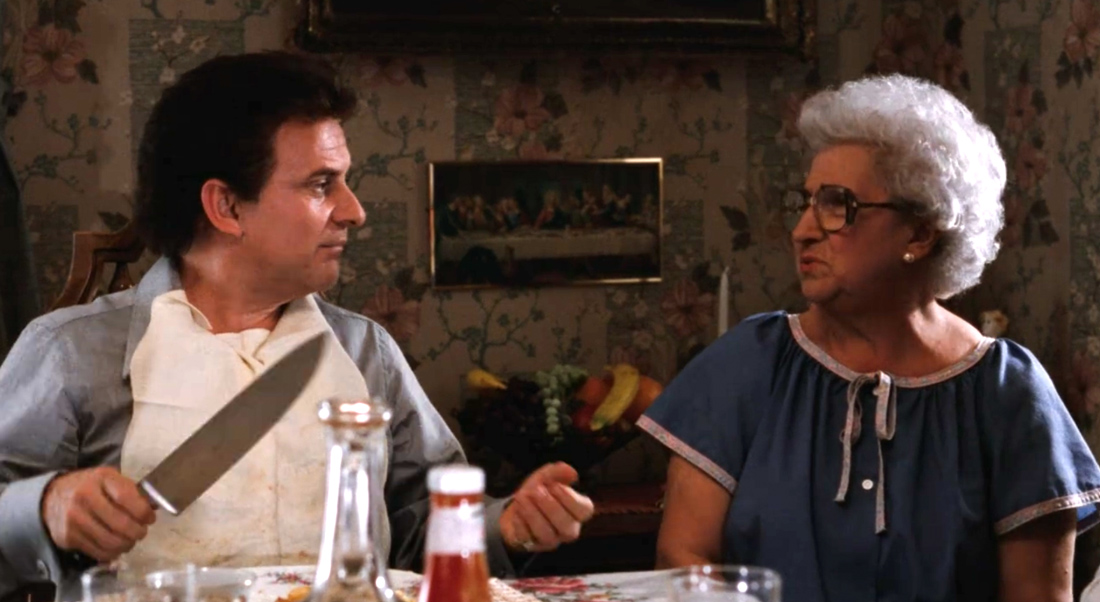
It’s probably not too controversial to choose the shine box, the dinner at Tommy’s, and the dog painting as the best scene of Goodfellas. It was, after all, the scene Scorsese chose to tease at the beginning of the movie. There’s a lot to love about it, from Pesci’s volcanic reaction to “you insulted ‘im a lil bit.” But for my money, Martin Scorsese’s mom (playing Tommy’s mom) steals the entire scene. It probably helps that the hair, the shirt, and the way that her love takes the form of forcefeeding people is uncannily reminiscent of my own grandmother.
In particular, when Tommy tells his cockamamie story about needing her kitchen knife to cut off the deer’s paw (“the hoof,” Jimmy helpfully corrects as Tommy fumbles for the word) and she recoils while making that “Ssssss” sound… It gives me goosebumps. It’s like I’m back in the car with my grandma, wordlessly criticizing my father’s driving. I’ve never loved a complete stranger the way I love Catherine Scorsese.
Meanwhile, the scene, which begins as a tense confrontation, turns into a sitcom without missing a beat. Tommy fumbling around for the word for hoof, Mama Devito’s joke that she says sounds better in Italian (“Shut up, you’re always talking?”), and finally the weird painting that looks like the guy in the trunk, is like a joke with an escalating series of tags, a moody bridge, and a final punchline that shatters the tension. And because it’s all in the context of a side journey while trying to get rid of a body (the body of a made man, who it turns out is still alive…), the whole dinner has the effect of a whispered joke you hear at a funeral. You know you shouldn’t laugh, and trying to stifle it makes it ten times funnier. God, I love it so much.
Vince Mancini is on Twitter. You can access his archive of reviews here.
